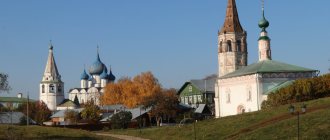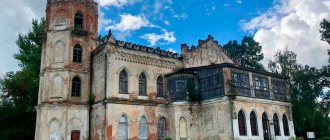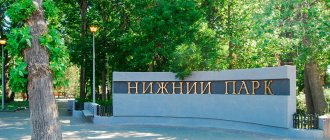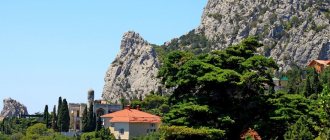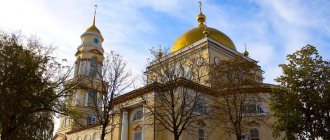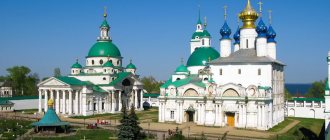Countries > Russia
Rostov the Great has an amazing history: it experienced its heyday several centuries ago, when it had significant political and religious influence. However, now it is a small city in the Yaroslavl region. The heyday left unique architectural monuments that have survived to this day. Most of them are concentrated on the territory of the Kremlin, and mainly they attract tourists to the Golden Ring. But besides them, there are several more interesting places to see. More details in this post.
- Story
- Attractions
- Rostov Kremlin
- Assumption Cathedral
- Hodegetria Church
- Metropolitan Garden
- Rostov enamel
- Church of the Savior at Torg
- Excursions
- Lake Nero
- Neighborhood
- Spaso-Yakovlevsky Dimitriev Monastery
- Church of St. John the Evangelist on Ishna
- Map
- General impressions
Story
Now Rostov is primarily a city in the south of Russia, but it was Rostov in the Yaroslavl region that appeared nine centuries earlier and was once very important.
The heyday dates primarily from the 11th to 13th centuries, when it was the center of the Rostov-Suzdal principality. It was the administrative and religious center of the region. However, later Moscow acquired greater strategic influence, which subsequently deprived the principality of political independence and left Rostov only with important religious powers. But then the main diocese was moved to Yaroslavl, depriving it of this function. Then it becomes a shopping center with the largest fair in the area.
Since the 19th century, a real decline begins: gradually, only the architecture remains of its former greatness, and it becomes a small county town. Despite the fact that now it is practically not developing, Rostov the Great has preserved an impressive historical heritage, attracting many tourists traveling along the Golden Ring.
Historical and architectural monuments of Rostov
Even the most fastidious traveler will not have any problems with what to see in Rostov. Here, at every step, you can find monuments of Russian architecture from different historical eras.
Shopping arcades
- Address: st. 50 years of October, 1. Transport stop “Kremlin”.
Just 200 years ago, Rostov was one of the largest shopping centers in the country. Suffice it to say that every spring the third largest fair in all of Russia was held here. In order for visitors and local merchants to be able to present their goods in person, trading rows were built, occupying an entire city block. At the end of the 18th century. wooden buildings were replaced with stone ones. The complex of Trade Rows acquired its final form a century later, when it was replenished with the buildings of Mytny and Gostiny Dvors. The architectural ensemble with galleries, colonnades and arcades is impressive even today.
Gymnasium building
- Address: st. Moravskogo, 6. Transport stop “Gymnasium named after. Kekina."
The architectural dominant of Moravskogo Street, leading to Kolkhoznaya Square in Rostov, is the ceremonial building of the city gymnasium. The construction of a pompous mansion, built with the money of a wealthy merchant, a wonderful philanthropist A.L. Kekin, completed in 1910. The small palace, decorated in the neoclassical style, not only added to the list of city attractions, but also became a real center of education. In addition to the usual classrooms, under its vault there was a main auditorium for 300 people, a gymnasium and even an observatory. Many educational institutions in provincial cities could then envy such equipment.
Selivanov's House
- Address: st. Okruzhnaya, 5. Transport stop “Pharmacy No. 63”.
The luxurious mansion on Okruzhnaya Street could easily fit into the ensemble of Nevsky Prospect in St. Petersburg . The Art Nouveau palace belonged to the Selivanov family of merchants before the October Revolution. The building received its current appearance after a large-scale reconstruction carried out at the beginning of the last century. Then the stone house of the Catherine era was added with two different-story wings, converging to an elegant bay window with a dome. Unfortunately, the historical interiors of the mansion have been lost, but from the outside it looks wonderful.
Bell tower of the Church of the Exaltation of the Cross
- Address: Sovetskaya Square, 19. Transport stop “Pharmacy No. 63”.
Even 150 years ago, the church in the name of the Exaltation of the Holy Cross on the main shopping square of the city was considered one of the calling cards of Rostov. However, time has not been kind to the temple. From the complex of religious buildings, only the four-tiered bell tower has survived to this day. The elegant tower, a monument of architectural classicism, was not demolished in the 30s of the last century only because the fire department, built on the ruins of the destroyed temple, needed an observation tower. Later, chimes were installed on the bell tower, which had lost its dome and cross. Looking at the tower, one can only imagine how magnificent the lost Church of the Exaltation of the Cross was.
Monument to the deer
- Address: st. Dostoevsky. Transport stop "Fevralskaya Street".
Historically, in Rostov the Great, which amazes with the abundance of architectural attractions, there were almost no monumental decorations. For a long time, rumors about the installation of a monument to Prince Vasilko in the city were actively circulated among the local community. However, the project did not come to fruition. But a bronze statue of a deer recently appeared on Obezdnoye Highway. Now the image of the proud animal adorns not only the Rostov coat of arms, but also the entrance to the city. Tourists enjoy taking pictures against the background of the monument.
Main attractions
Rostov Kremlin
The Rostov Kremlin was built in the 17th century according to the design of Iona Sysoevich, an associate of Nikon. Trying to create an ideal place, close to the image of paradise, Jonah created several projects in his metropolis, according to which famous monasteries were built in Borisoglebsk, Uglich and Rostov. After the transfer of the metropolis to Yaroslavl, the decline also affected the Kremlin: its buildings were severely destroyed. Only at the beginning of the 20th century large-scale restoration work began to be carried out.
Despite the large number of people, there is an incredibly calm atmosphere here, and it is easy to mentally transport yourself back several eras.
The Kremlin has more than once been included in the list of symbols of Russia - being an expressive example of the flowering of architecture of the 17th century, in the general view it is apparently also an example of typical “Russian architecture”.
Red Chamber
Famous films were filmed in the Rostov Kremlin: “Ivan Vasilyevich Changes His Profession”, “Boris Godunov”, “The Incredible Adventures of Italians in Russia” and others. Almost all of them took place in one way or another around the Red Chamber, a civil building from the 17th century. Her expressive “Russian” style is perfect for historical settings. Now there is a restaurant inside, the interiors of which are stylized as antique.
Cathedral Square, 8
Working hours: 10:00-17:00
Entrance: 70 rubles, with all exhibitions and expositions - 750 rubles.
Assumption Cathedral
Once the cathedral was the main one for the entire Yaroslavl diocese, but after the transfer of the metropolis to Yaroslavl it began to fall into decay. Restoration in the 1980s and 90s saved it from destruction, and its original appearance was restored.
The modern building was built in the 16th century on the site of older temples. In the Assumption Cathedral you can see how the interiors usually look without restoration.
Museum-Reserve "Rostov Kremlin"
Rostov-Yaroslavl Museum of Architecture and Art…
Rostov
In 1883, the Museum of Church Antiquities opened in the White Chamber of the Rostov Kremlin; later it received the status of an all-Russian museum. The Kremlin has finally lost its religious function, but the presence of a museum on its premises has made it possible to preserve the architectural ensemble of the former residence.
Today, the Rostov Kremlin Museum-Reserve displays more than 180 thousand valuable exhibits, among them ancient Russian icons, Yam bells, and an altar cross from the 16th century. Here is the largest collection of enamel items in Russia - about 2.5 thousand miniatures from the 18th to 20th centuries.
Church of the Savior at Torg
The modern building of the Church of the All-Merciful Savior in Torg was built in the 17th century. Once upon a time it was located between the shopping arcades of Gostiny Dvor, which is why it received such a name. The blue dome is decorated with stars.
Shopping arcades
Like Suzdal or Kostroma, Rostov has its own “Gostiny Dvor” with shopping arcades. This is a typical building for that time in a classical style with arched entrances to each merchant's shop. Together with the church they form a single architectural complex. The rows are still primarily used for trading.
Tolga Church
The Church of the Tolgskaya Icon of the Mother of God is the only city religious institution that continued its work during Soviet times. A neat but elegant temple was built in the 18th century. The relics of John the Merciful are kept inside.
Wiki/Commons
Ascension Church
The ancient Church of the Ascension of the Lord was abandoned for a long time and was plundered several times. Fortunately, the frescoes were preserved, but the unique wooden carved iconostasis was lost.
Museum of Rostov Merchants
In the small mansion, the interiors have been completely recreated and items from merchant life have been preserved. Here you can imagine how provincial merchants lived two centuries ago and get acquainted with the history of the famous Rostov Kekin family.
Leninskaya st., 32
House of Crafts
The House of Crafts contains works of craftsmen engaged in folk crafts and decorative arts. For example, objects made of black-polished ceramics, birch bark and wood carvings. However, this is not a simple exhibition. Here you can take part in master classes and try to learn how to make dolls, products from birch bark or wood. For example, whistle toys, majolica figurines or ceramic pots. Excursions and events dedicated to Russian folklore are regularly organized. The house is located in the very center.
From the website domremesel.com
2nd passage of Tolstoy embankment, 16
Khors Art Gallery
A unique museum, the exhibition of which presents a wide collection of artistic enamel. It contains both ancient works of art and modern art objects by artists from all over Russia. Some of the presented objects can be purchased. In addition to the regular exhibition, exhibitions dedicated to contemporary art and master classes are regularly held for those wishing to master the unusual skill of making objects from enamel.
st. Podozerka, 31
Spaso-Yakovlevsky Monastery
The Spaso-Yakovlevsky Cathedral contains the relics of St. James and Dmitry of Rostov, the first of whom founded the holy monastery, building a wooden church after being expelled from his hometown for the release of a woman sentenced to death, and under the second, the monastery achieved unprecedented power and prosperity. The monastery was visited several times by royalty.
The heyday of the monastery was cut short with the advent of Soviet power; in 1923 the monastery was closed, the monks were dispersed, the property was looted, the premises were given over to military warehouses. Only in 1991 did the restoration of the monastery begin, returning it to its former life.
INTERESTING On the territory of the monastery there is a spring with healing holy water.
Excursions
Despite its small territory, the history of Rostov the Great is so rich that it will be quite difficult to prepare on your own. If you don’t want to miss anything interesting and learn more about the unusual history of the city, you should book a tour with a local professional guide:
City Park
The main recreational place for residents is the city park. It is located west of the center on the shores of Lake Nero. The green and calm park is perfect for relaxing and walking. Several years ago, its landscape was reconstructed and landscaped, in particular, more recreational and children's areas appeared.
Where to go with children in Rostov
Travelers coming to Rostov have the opportunity to immerse themselves in the romantic atmosphere of ancient epics and legends. There are many interesting places here that definitely need to be shown to your child.
Museum "Frog Princess"
- Opening hours: daily, from 10:00 to 18:00.
- Ticket price: adult 150 rubles, children 100 rubles.
- Telephone.
- Website: https://www.carevna.net/museum_carevna.html
- Address: st. Leninskaya, 20. Transport stop "Spartak Stadium"
Rostovites are sure that the famous Frog Princess once fell in love with the luxurious water lilies of Lake Nero. This axiom even has a historical basis. According to scientific research, today's townspeople are descendants of Finno-Ugric tribes who worshiped the frog! The city has a colorful museum dedicated to the heroine of a folk tale. Young visitors are always welcome here, for whom a wonderful interactive program has been prepared with the participation of Koshchei the Immortal, Vasilisa the Wise and the Frog Princess herself in many incarnations.
City Park
- Opening hours: daily, except Mondays, from 10:00 to 22:30.
- Telephone.
- Address: recreation between Sovetskaya Square and the shore of Lake Nero. Transport stop "Sovetskaya Square".
In the first half of the 19th century. On the initiative of the local nobility and merchants in Rostov, it was decided to open the City Garden. On the recreational territory allocated by the authorities along the shore of Lake Nero, alleys, flower beds, comfortable benches, and a pier for boat trips soon appeared. A little later, a wooden building was built here for performances of touring circuses and theaters. By the end of the last century, the park complex fell into disrepair. In order to restore it to its former glory, a large-scale reconstruction was needed. After the planned works were completed in 2012, the park became much more attractive and comfortable. Here you can spend a wonderful fine day with your child, enjoying the splendor of nature. There is entertainment for children of all ages.
Alyosha Popovich Museum
- Schedule:
- Ticket price: from 50 rub. up to 300 rubles, depending on the intensity of the selected program.
- Telephone.
- Website: https://www.pleshanov-tour.ru/suvlav.php
- Address: st. Frunze, 21A. Transport stop "Polyclinic No. 1".
Do you want to take a photo next to the epic hero, treat yourself to the dishes that the Russian knights ate, and try on the armor of warriors? Then visit this wonderful museum and be sure to take your child with you! The romantic atmosphere of ancient legends is clearly felt here. Guests will enjoy an interactive tour of the heroic tower, competitions in archery and other fun activities, tea drinking, and a photo shoot. Young and adult tourists take part in a quest on the territory of the heroic farmstead and receive as a gift a clay figurine of a fairy-tale hero, which they can paint with their own hands under the guidance of a master.
You may be interested in the sights of Gavrilov-Yam, Rybinsk, Pereslavl-Zalessky, Uglich and Yaroslavl.
A trip to Rostov will bring a lot of unforgettable impressions to tourists of any age. Everything here is imbued with the spirit of ancient Orthodox Rus' - generous for friends and fierce for enemies. Perhaps this is why the most revered saints were born and lived here, the flow of pilgrims to whose relics has not stopped for many centuries.
Neighborhood
Spaso-Yakovlevsky Dimitriev Monastery
From the lake you can see the ancient Spaso-Yakovlevsky Dimitriev monastery, founded in the 14th century. Most of the surviving buildings were built later, and their architecture is significantly different from the Kremlin - it is more classical and baroque style. The monastery's cathedrals will also be of interest for their ancient frescoes.
Church of St. John the Evangelist on Ishna
Another important attraction is the Church of St. John the Theologian, which is located in the vicinity of Rostov in the Bogoslov area. It was built in 1687 and is a unique wooden monument preserved from that time. You can see many carved elements in the temple. Inside there is a copy of the Royal Doors from 1562.
village of Bogoslov
Working hours: 10:00-17:00
Entrance: 80 rub.
Trinity Sergius Varnitsky Monastery
A few kilometers from Rostov in 1427, on the site where Sergius of Radonezh had previously been born and raised, local Archbishop Ephraim founded a temple. Initially, the building was wooden, and only by the middle of the 18th century, thanks to the funds of Bishop Afanasy Volsky, it became stone. Later, with donations from Rostov merchants, the Winter Church and the Church of the Presentation were built.
During the Soviet era, the monastery was almost completely destroyed, and only the Vvedenskaya Church and a few cells survived.
Since 1995, during the process of restoration work, the monastery was practically rebuilt, bringing the architecture of the building as close as possible to its original appearance.

